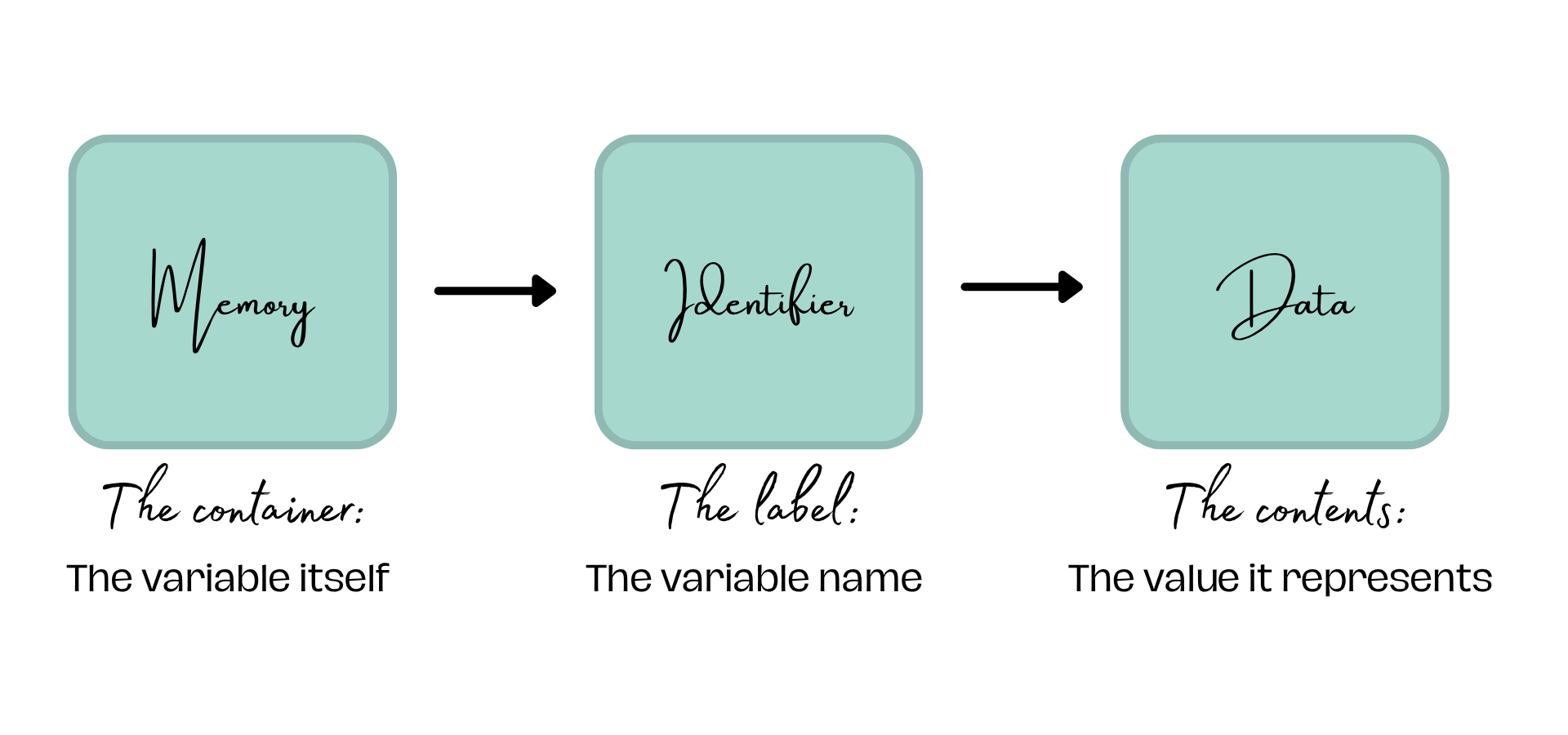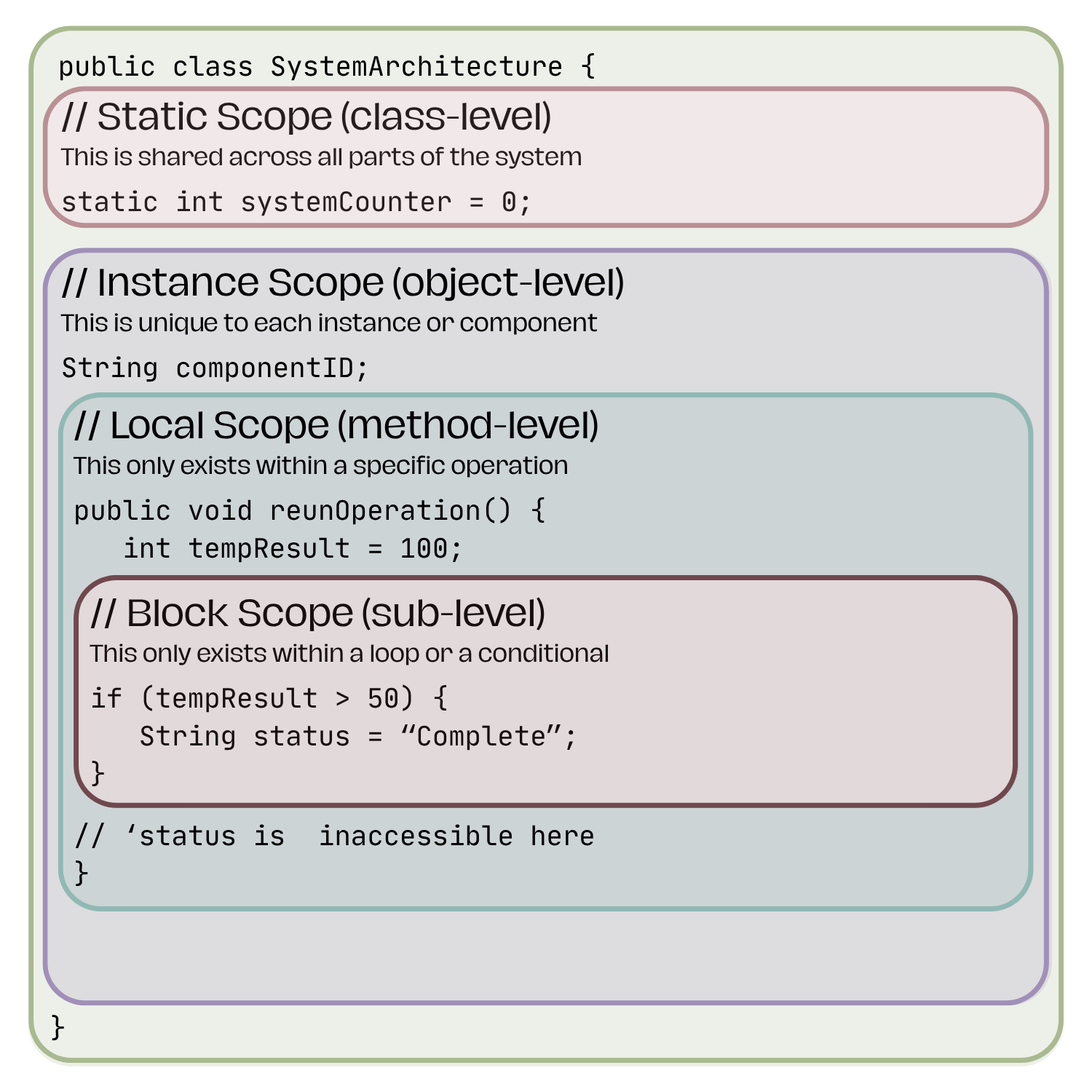Welcome to this lesson on variables! Variables are one of the most fundamental concepts in programming. Mastering them is a key step on your journey to becoming a proficient programmer. Think of them as the basic memory containers that allow your programs to store and manage information.
What is a Variable? The "Box" Analogy
At its core, a variable is a way of storing information that your program can use and change. Imagine you have a collection of boxes:
The Box itself: This represents your variable. It's a container in the computer's memory.
The Label on the Box: Every box needs a label so you know what's inside without opening it. This is the variable name. It's a unique identifier you give to your variable.
The Contents of the Box: Whatever you put inside the box is the value that the variable holds or represents. This could be a number, a piece of text, a true/false status, or more complex types of data.
Key Idea: You can change the item inside the box (the value), but the label on the box (the variable name) generally stays the same once you've created it.
Why are Variables Important?
Variables are crucial because they allow programs to be dynamic and flexible. Instead of writing code that only works with fixed pieces of information, variables let us:
Store data that can change over time (e.g., a game score, a user's input).
Refer to data by a meaningful name, making code easier to read and understand.
Reuse values in multiple places without retyping them.
Perform operations on data (e.g., add two numbers stored in variables).
Without variables, programs would be incredibly limited and much harder to write.
Naming Your Variables: Clarity is Key
Choosing good variable names is extremely important. The name is how you (and others reading your code) will understand what piece of information the variable is holding.
Rules for Naming Variables (Common Across Many Languages):
No Spaces: Variable names cannot contain spaces. If you try to use a space, the programming language's compiler or interpreter will likely think the first word is the variable name and the second word is a separate piece of code, leading to errors.
Instead of:
motor speedUse:
motorSpeed,motor_speed, ormotorspeed(conventions vary).
Case Sensitivity: Most programming languages are case-sensitive. This means
myVariableis different frommyvariableandMyVariable. You must be consistent with the capitalization you choose throughout your code when referring to a specific variable.age = 25;is different fromAge = 25;
Naming Conventions and Best Practices:
While different organizations or programming languages might have slightly different preferred styles (like camelCase vs. snake_case), some general principles apply:
Be Descriptive but Concise: The name should clearly indicate what the variable represents without being excessively long.
Good:
userName,itemPrice,loopCounter,totalScoreLess Clear:
x,val,num(unless in a very specific, limited context where meaning is obvious)
Start with a Letter (Usually): Most languages require variable names to begin with a letter or sometimes an underscore. They usually cannot start with a number.
Use Meaningful Names for Booleans: Boolean variables store
trueorfalsevalues. Their names should often sound like a yes/no question or a state.Good:
isActive,isLoggedIn,hasPermission. WhenisOnistrue, the thing is on. When it'sfalse, the thing is off.
Follow Conventions:
Camel Case:
firstName,shoppingCartTotal. The first word is lowercase, and subsequent words start with an uppercase letter. This is common in Java, JavaScript, and C#.Pascal Case:
FirstName,ShoppingCartTotal. All words start with an uppercase letter. Often used for class names.Snake Case:
first_name,shopping_cart_total. Words are separated by underscores. Common in Python and Ruby.
Declaring a Variable: Bringing it to Life
Before you can use a variable in your program, you must declare it. Declaration is the process of telling the programming language that you want to create a variable. It involves:
Giving it a Name: You specify the label for your "box."
Specifying its Data Type (in some languages): Many languages, like Java, are statically-typed. This means you must tell the computer what kind of data the variable will hold (e.g., a whole number, a number with decimals, text, etc.). Other languages, like Python or JavaScript, are dynamically-typed, where you don't always have to explicitly state the type at declaration.
Variable Declaration in Java:
In Java, a typical variable declaration looks like this:
dataType variableName = value;
dataType: Specifies the type of data the variable can store (e.g.,intfor integers,doublefor floating-point numbers,Stringfor text,booleanfor true/false).variableName: The name you choose for the variable (following naming rules).=: The assignment operator. It's used to give the variable a value.value: The initial piece of data you are storing in the variable.;: The semicolon marks the end of the statement in Java.
Examples in Java:
int playerScore = 0; // Declares an integer variable named playerScore, initialized to 0.
String userName = "Alex"; // Declares a String variable named userName, initialized to "Alex".
boolean isActive = true; // Declares a boolean variable named isActive, initialized to true.
double itemPrice; // Declares a double variable named itemPrice without an initial value.
itemPrice = 19.99; // Assigns a value to itemPrice later.
Even if you don't assign a value immediately, you still need to declare its name and, in Java, its type. Don’t worry, the next lesson is on data types.
Variable Scope: Where Can You Access It?
Scope refers to the region of your code where a variable can be legally accessed and used. Not all variables are accessible from all parts of your program. Understanding scope is crucial for avoiding errors and writing well-organized code.
Here are common types of variable scope, with a focus on Java concepts:
Local Variables:
Definition: These variables are declared inside a method (a block of code that performs a specific task) or within a smaller block of code like a loop (
for,while) or anifstatement.Accessibility: Local variables "live" and "die" within the block they are declared in. They can only be accessed from within that specific method or block (between the
{and}curly braces where they are defined).Example (Java):
public void calculateSum() { int num1 = 10; // num1 is local to calculateSum int num2 = 20; // num2 is local to calculateSum int sum = num1 + num2; // sum is local to calculateSum System.out.println(sum); if (sum > 0) { String message = "Positive sum"; // message is local to this if-block System.out.println(message); } // System.out.println(message); // ERROR! message is not accessible here. } // System.out.println(num1); // ERROR! num1 is not accessible here.
Instance Variables (Fields or Member Variables):
Definition: These variables are declared inside a class but outside of any specific method. They belong to an instance (an object created from a class).
Accessibility:
They are available to all non-static methods within that class.
Each object (instance) of the class gets its own copy of these variables. So, if you have two
Dogobjects, each can have its ownnameandage.They cannot be directly used within
staticmethods (unless accessed through an object of the class).
Example (Java):
public class Dog { String name; // Instance variable int age; // Instance variable public Dog(String dogName, int dogAge) { this.name = dogName; // 'this.name' refers to the instance variable this.age = dogAge; } public void bark() { System.out.println(name + " says Woof!"); // Can access instance variable 'name' } public static void main(String[] args) { Dog myDog = new Dog("Buddy", 3); myDog.bark(); // Accesses 'name' through the myDog object // System.out.println(name); // ERROR! Cannot directly access non-static 'name' from static main } }
Static Variables (Class Variables):
Definition: These variables are declared with the
statickeyword. They belong to the class itself, not to any particular instance (object) of the class.Accessibility:
There is only one copy of a static variable, shared among all instances of the class.
They can be accessed by any method within the class, both static and non-static.
If the class is
public, they can often be accessed from outside the class using the class name (e.g.,ClassName.staticVariableName).
Example (Java):
public class Car { String model; // Instance variable static int numberOfCarsCreated = 0; // Static variable public Car(String modelName) { this.model = modelName; numberOfCarsCreated++; // Increment the static counter } public void displayModel() { System.out.println("Model: " + model); } public static void displayTotalCars() { System.out.println("Total cars created: " + numberOfCarsCreated); // System.out.println(model); // ERROR! Cannot access non-static 'model' here } public static void main(String[] args) { Car car1 = new Car("Sedan"); Car car2 = new Car("SUV"); System.out.println(Car.numberOfCarsCreated); // Access static variable using class name Car.displayTotalCars(); // Call static method } }
Key Takeaways
-
Named containers for data, allowing for easier reuse
-
Variables allow us to access data more easily and keep track of how we are using that data
-
Good variable names make it easier to read and understand your code
-
Variable scope is where you can access that variable


